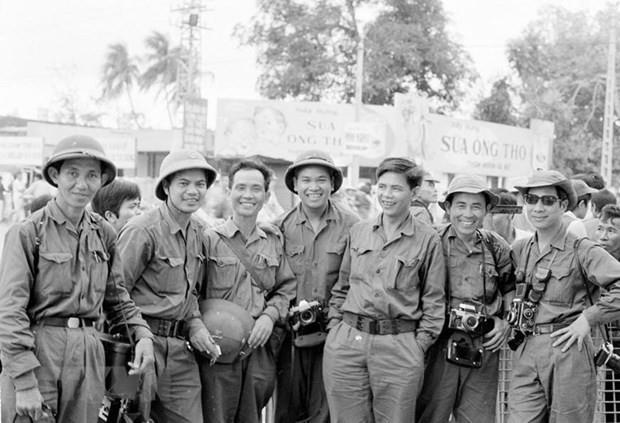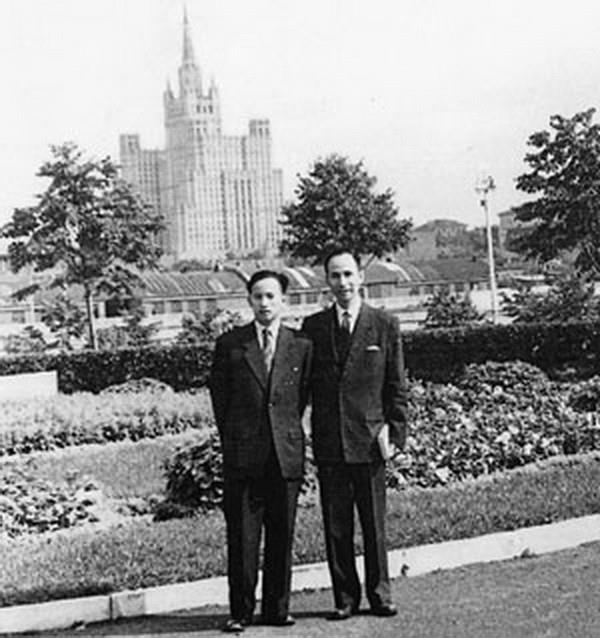 Society
Society

 |
| Field reporters from the Vietnam News Agency and the Liberation News Agency during the Hồ Chí Minh Campaign in April 1975. VNA/VNS File Photo |
HÀ NỘI Many Vietnam News Agency (VNA) journalists and staff members fell in battlefields while very young, leaving behind unfinished writings and profound memories in the hearts of loved ones.
Their sacrifice will be still remembered and honoured today.
Journalist Phan Hoài Nam was born into a family of five siblings on October 9, 1940, in Điện Quang Commune, Điện Bàn District, in the former Quảng Nam Province (now part of Đà Nẵng City following recent merger).
His father was the renowned poet Xuân Tâm. At the end of 1954, Nam moved north with his family during the mass migration and studied at a school for southern students in the north.
Bright and academically gifted, Nam was sent to study journalism in the then Soviet Union. After returning, he pursued literature at Hà Nội General University.
In early 1966, as the resistance war against the US intensified, he volunteered to enter the southern battlefield, becoming a correspondent for the Liberation News Agency.
From that moment, his life became intertwined with front-line reporting.
He developed a deep romance with a doctor working in the southeastern battlefield. They planned to marry, but that day would never come.
Trần Tố Nga, a former Liberation News Agency war reporter and key figure in the internationally known Agent Orange lawsuit, shared her memories of Nam, saying they had a very close bond.
“We studied together in the middle school for southern students until Grade 8, around 1957–1958, along with poet Lê Anh Xuân. I joined Liberation News Agency in June 1966, and Nam came about a month later,” Nga said.
“We were old classmates and colleagues, so we were very close. Nam was already a capable reporter and editor, while I had no journalism training and started as a documentation clerk. My daily job was simply copying article headlines,” she said.
In September 1967, while returning from the second congress of Southern Liberation Armed Forces Heroes and Emulation Fighters, a cultural delegation including many famous artists and reporters — poet Lê Anh Xuân, journalist Thép Mới, photographer Đinh Thúy and Phan Hoài Nam — was spotted by enemy aircraft and bombed.
 |
| Journalist Phan Hoài Nam (left) and his father, poet Xuân Tâm in Moscow in 1962. VNA/VNS File Photo |
Nga recounted: “Two fighter jets skimmed the treetops. Everyone was terrified, unsure where to run. A cluster bomb suddenly fell and exploded. We dashed into the forest. Each time a bomb went off, we lay flat, then kept running. I narrowly escaped death. Unfortunately, Đinh Thúy and Nguyễn Đình Cước were killed.”
“With no shovels, we buried our comrades with our bare hands. Then Nam and I, along with others, carried the injured and the belongings of the fallen through the night,” Nga said.
Nga remembers Nam as a brave, selfless reporter who always thought of others first.
“Once, while walking in the jungle, enemy planes opened fire from behind. Nam shielded me and said ‘If anyone must die, let it be me,’” she said.
Nam also mentored her in writing her first articles for the main agency.
During the 1968 Tết Offensive, many Liberation News Agency reporters were dispatched to cover the battlefield, including Nam.
Before heading out, he entrusted Nga with a metal ammunition box containing his personal belongings.
He was assigned to the Cần Giuộc front in Long An Province (now part of Tây Ninh Province after recent merger).
After the first phase of the offensive, while others withdrew, Nam volunteered to stay for the second phase — not as a journalist, but as a guerrilla fighter.
His sister, Phan Thị Mỹ Liên, said the family only learned of his death much later.
Their father, poet Xuân Tâm, was the first to receive the devastating news but chose to keep it from his wife, who had a heart condition.
His death was revealed to his family long afterwards, when everyone was healthy enough to cope with the loss.
Only in 1994 was Nam’s grave located in a Long An cemetery. Thanks to the efforts of Trần Tố Nga and a specialist in locating war martyrs, the family was able to bring his remains home to rest at the HCM City Martyrs’ Cemetery.
Two brothers lost in war
In a modest home on Trần Quốc Toản Street in Hà Nội, Nguyễn Đức Đông quietly shared memories of his two older brothers, VNA journalists Nguyễn Đức Yên and Nguyễn Đức Thanh, who died in the anti-American resistance.
The elder brother, Yên, was a photo technician at VNA’s Photography Bureau at 18 Trần Hưng Đạo Street.
In 1963, he joined the army and went south. In 1969, the family was informed that he had died in action.
In 1976, after the war ended, the family went to Quảng Nam Province to search for his grave.
With the help of preserved letters and local villagers, they found someone who had buried him in the forest near Phước Lãnh Commune, Tiến Phước District.
In 1996, after two decades of searching, his remains were brought back to Hà Nội.
His younger brother Thành, born in 1945, joined the VNA’s photography team around 1965–1966. Known for being diligent and kind, he also looked after the children of staff evacuated to Vĩnh Phúc Province.
After the 1968 Tết Offensive, he was deployed to work in the central region.
Đông tearfully recalled the day they saw Thành off.
Thành hugged his father and younger brother, handing Đông some dry rations before boarding. It was their last farewell. Just two months later, on May 8, 1968, the family received a death certificate which confirmed Thành’s sacrifice on the battlefield.
Finding Thành’s grave took many years due to vague details about his death.
Eventually, a specialist helped guide the family to Nầm Cemetery in Hà Tĩnh Province, where his grave was found beside an anonymous mass grave.
For Đồng's family, the search for their brothers’ remains was a long-standing pain that only eased once their loved ones were brought home.
Their return fulfilled a sacred duty — not just to the living, but to honour the fallen heroes who gave their youth and lives for the revolution and the nation’s news service. VNS




